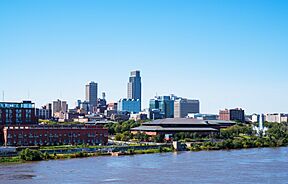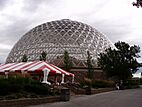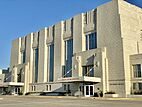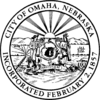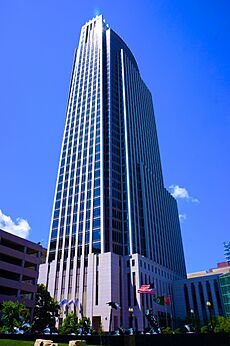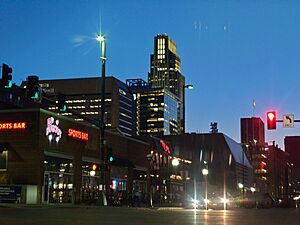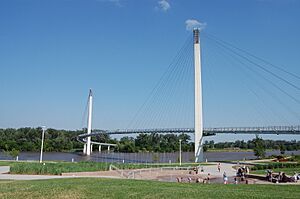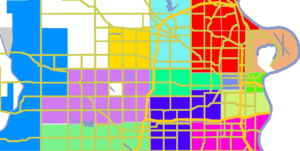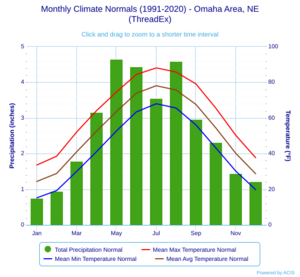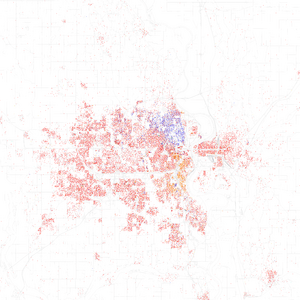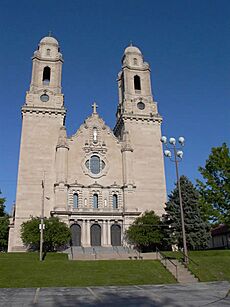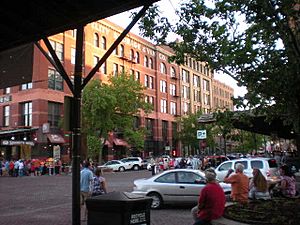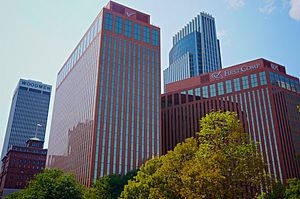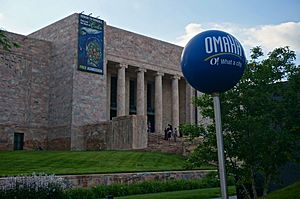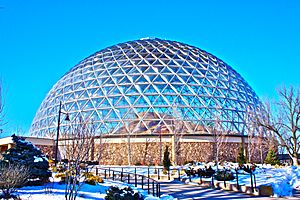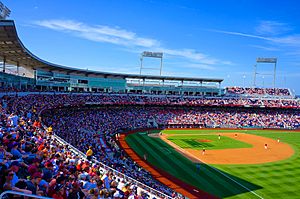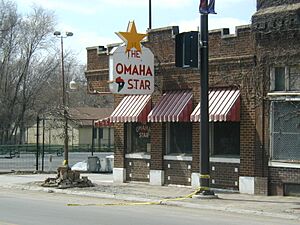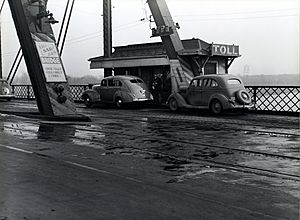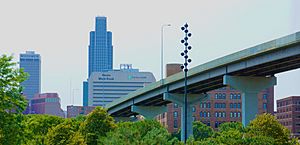Omaha, Nebraska facts for kids
Quick facts for kids
Omaha
|
|||
|---|---|---|---|
|
|||
| Nickname(s):
Gate-city of the West, The Big O
|
|||
| Motto(s): | |||
| Country | |||
| State | |||
| County | Douglas | ||
| Founded | 1854 | ||
| Incorporated | 1857 | ||
| Named for | Omaha people | ||
| Government | |||
| • Type | Strong mayor–council | ||
| Area | |||
| • City | 146.28 sq mi (378.85 km2) | ||
| • Land | 142.67 sq mi (369.51 km2) | ||
| • Water | 3.61 sq mi (9.35 km2) | ||
| Elevation | 1,060 ft (320 m) | ||
| Population
(2020)
|
|||
| • City | 486,051 | ||
| • Estimate
(2023)
|
483,335 |
||
| • Rank | 40th in the United States 1st in Nebraska |
||
| • Density | 3,658.41/sq mi (1,315.40/km2) | ||
| • Urban | 819,508 (US: 55th) | ||
| • Urban density | 3,026.1/sq mi (1,168.4/km2) | ||
| • Metro | 967,604 (US: 58th) | ||
| Demonym(s) | Omahan | ||
| Time zone | UTC−06:00 (CST) | ||
| • Summer (DST) | UTC−05:00 (CDT) | ||
| ZIP Codes |
68101-68114, 68116-68119, 68122, 68124, 68127, 68130-68132, 68134-68139, 68142, 68144-68145, 68147, 68152, 68154, 68157, 68164, 68172, 68175-68176, 68178-68180, 68182-68183, 68197-68198
|
||
| Area code | 402 and 531 | ||
| FIPS code | 31-37000 | ||
| GNIS feature ID | 0835483 | ||
Omaha (/ˈoʊmə[unsupported input]/ OH-mə-hah) is the largest city in Nebraska, a state in the Midwestern United States. It's also the main city of Douglas County. Omaha is located along the Missouri River, about 10 miles (16 km) north of the Platte River.
In 2020, Omaha had a population of 486,051 people. This makes it the 40th most populated city in the United States. The larger Omaha–Council Bluffs area, which includes parts of Iowa, has over 967,000 residents.
Omaha was founded in 1854 by people from nearby Council Bluffs, Iowa. It quickly became known as the "Gateway to the West" because of its location on the Missouri River. In 1898, Omaha hosted the Trans-Mississippi Exposition, a big fair that showed off the growth of the Midwest. The city became a major transportation hub in the 1800s, especially for railroads. Later, its stockyards (where livestock were kept) and meatpacking plants became famous worldwide.
Today, Omaha is home to the main offices of four huge companies listed in the Fortune 500: Berkshire Hathaway, Kiewit Corporation, Mutual of Omaha, and Union Pacific Corporation. Other important companies like First National Bank of Omaha and Gallup, Inc. are also based here.
Omaha has many cool places to visit, like the Henry Doorly Zoo and Aquarium, the historic Old Market, and the Durham Museum. It also hosts the yearly College World Series baseball tournament. Fun facts about Omaha: the Reuben sandwich, cake mix, and the TV dinner were all invented here! The first ski lift in the U.S. and the Top 40 radio format also started in Omaha.
Contents
- Omaha's Story: A Look at Its Past
- Where is Omaha? Geography and Neighborhoods
- Who Lives in Omaha? Demographics and People
- Omaha's Economy: A Business Hub
- Arts and Culture: Fun Things to See and Do
- Sports in Omaha: Home of Champions
- Parks and Recreation: Get Outdoors in Omaha!
- Education: Learning Opportunities in Omaha
- Media: News and Entertainment
- Infrastructure: How Omaha Works
- Famous People from Omaha
- Omaha's Sister Cities
- See also
Omaha's Story: A Look at Its Past
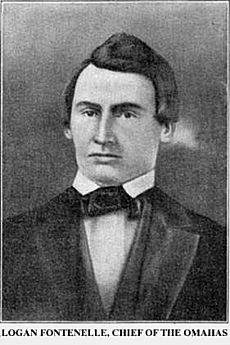
Long before Omaha was a city, different Native American tribes lived here. These included the Omaha, Ponca, Pawnee, Otoe, Missouri, and Ioway tribes. The word Omaha means "Upstream People" or "Against the Current" in the Omaha language.
In 1804, the famous Lewis and Clark Expedition explored the riverbanks where Omaha now stands. They met with tribal leaders nearby. Over the years, fur traders set up posts in the area. In 1846, Mormons built a temporary town called Cutler's Park.
The land that became Omaha was given up by the Omaha Tribe in 1854 through a treaty with the U.S. government. Logan Fontenelle, an interpreter for the Omaha, played a key role in this agreement.
Pioneer Days in Omaha
Before it was officially allowed, William D. Brown started a ferry service called the Lone Tree Ferry. This ferry brought settlers from Council Bluffs, Iowa, to the Omaha area. Brown is often seen as the first person to imagine a city here.
In 1854, Omaha was informally started with a picnic on Capital Hill. Soon after, the Omaha Claim Club was formed to help new settlers with land issues. Omaha became the capital of the Nebraska Territory. However, when Nebraska became a state in 1867, the capital moved to Lincoln.
Many early settlers stayed in hotels like the Douglas House. Important streets like Dodge Street and North 24th Street became busy business areas. Pioneers were buried in Prospect Hill Cemetery. Today, sculptures like Pioneer Courage celebrate Omaha's early history.
Omaha in the 1800s
Omaha's economy had its ups and downs in the early years. In 1858, the Omaha Daily Republican became Nebraska's first regional newspaper. Omaha was a key stop for people heading west. The steamboat Bertrand sank north of Omaha in 1865, and its artifacts are now on display at the Desoto National Wildlife Refuge.
The city grew a lot with the arrival of the railroads and the stockyards. Construction for the First transcontinental railroad began in 1863, and the Union Pacific Railroad started building west from Omaha in 1866. The Union Stockyards, founded in 1883, became huge. By the 1950s, many people in Omaha worked in meatpacking.
Immigrants from different countries created their own neighborhoods. These included Irish, Germans, European Jews, and African Americans from the South. There were also Little Italy and Little Bohemia. Wealthy families lived in fancy areas like the Gold Coast and Field Club. They enjoyed the city's beautiful park system, designed by Horace Cleveland.
In 1898, Omaha hosted the Trans-Mississippi and International Exposition, a big fair that attracted over 2 million visitors. The Indian Congress, which brought together more than 500 American Indians, happened at the same time.
Omaha in the 1900s
As Omaha grew, there were sometimes disagreements between workers and businesses. In 1909, a riot by earlier immigrants destroyed the city's Greek Town, causing the Greek population to leave.
The civil rights movement in Omaha started early, with the first chapter of the National Association for the Advancement of Colored People west of the Mississippi River opening here in 1912.
In 1913, a big tornado, the Omaha Easter Sunday Tornado, damaged many parts of the city, including the African-American community. Six years later, in 1919, a large crowd caused damage to the Douglas County Courthouse during a difficult time for the city. Troops from Fort Omaha were called in to help.
The culture of North Omaha was very active from the 1920s to the 1950s, with many creative people like Tillie Olsen and musicians like Lloyd Hunter.
After the Great Depression in the 1930s, Omaha recovered with the growth of Offutt Air Force Base nearby. During World War II, a factory there built B-29 bombers, including the Enola Gay. The Strategic Air Command moving to Bellevue in 1948 also helped the economy.
New highways like I-80 helped the city grow, but also divided some neighborhoods. In the 1960s, several riots in North Omaha damaged the area's economy.
Since the 1970s, Omaha has continued to expand, mostly to the west. Downtown Omaha has been rebuilt with new developments like the Gene Leahy Mall and the Old Market, which turned old warehouses into shops and restaurants. The Jobber's Canyon area was redeveloped into the ConAgra Foods campus.
Omaha in the 2000s
At the start of the 21st century, new skyscrapers and cultural places were built downtown. The One First National Center became Omaha's tallest building in 2002. The North Downtown area saw the building of the CenturyLink Center and TD Ameritrade Park, which now hosts the College World Series. The Union Pacific Center and Holland Performing Arts Center also opened.
West Omaha grew with new shopping centers like Village Pointe. The old Ak-Sar-Ben arena site became Aksarben Village, a mixed-use area with homes and businesses. Midtown Crossing at Turner Park also added new condos and shops.
Along the Missouri River, the Bob Kerrey Pedestrian Bridge opened in 2008, connecting Omaha to Council Bluffs for walkers and bikers. The RiverFront Place Condos also added new homes by the river.
Omaha has hosted the U.S. Olympic Team swimming trials several times, bringing many visitors to the city.
Where is Omaha? Geography and Neighborhoods
Omaha covers about 130.58 square miles (338.20 km2), with most of it being land. It's located in the Missouri River Valley. Other important water bodies include Lake Manawa, Papillion Creek, and Carter Lake.
The Omaha-Council Bluffs area includes eight counties: five in Nebraska and three in Iowa. This larger area is called a metropolitan area. Omaha is the 42nd largest city in the U.S.
Omaha is often seen as being in the "Heartland" of the United States. Efforts are made to protect natural habitats, like restoring prairies and managing whitetail deer.
Omaha has several hospitals, mostly along Dodge Street. As the county seat, it also has the county courthouse.
Omaha's Diverse Neighborhoods
Omaha is generally divided into six main areas: Downtown, Midtown, North Omaha, South Omaha, West Omaha, and East Omaha. West Omaha includes areas like Miracle Hills and Boys Town.
Early neighborhoods often formed around different ethnic groups, such as Little Italy, Little Bohemia, and Greek Town. Over time, Omaha grew by adding nearby communities like Florence, Dundee, and Benson.
Starting in the 1950s, many middle-class families moved to suburbs in West Omaha. More recently, people have worked to bring new life to Downtown and Midtown areas, like the Old Market and Turner Park.
Omaha's Weather: Hot Summers, Cold Winters
Omaha has a humid continental climate, meaning it has hot summers and cold winters. In July, the average temperature is around 76.7°F (24.8°C), with frequent thunderstorms. Temperatures can reach 90°F (32°C) about 29 days a year.
In January, the average temperature is 23.5°F (-4.7°C), and it can drop below 0°F (-18°C) about 11 days a year. The lowest temperature ever recorded was -32°F (-36°C) in 1884, and the highest was 114°F (46°C) in 1936. Omaha gets about 30.6 inches (777 mm) of rain each year, mostly in warmer months. It also gets about 28.7 inches (73 cm) of snow in winter.
| Climate data for Omaha (Eppley Airfield), 1981–2010 normals, extremes 1871–present | |||||||||||||
|---|---|---|---|---|---|---|---|---|---|---|---|---|---|
| Month | Jan | Feb | Mar | Apr | May | Jun | Jul | Aug | Sep | Oct | Nov | Dec | Year |
| Record high °F (°C) | 69 (21) |
78 (26) |
91 (33) |
96 (36) |
103 (39) |
107 (42) |
114 (46) |
111 (44) |
104 (40) |
96 (36) |
83 (28) |
72 (22) |
114 (46) |
| Mean daily maximum °F (°C) | 33.4 (0.8) |
38.1 (3.4) |
50.9 (10.5) |
63.7 (17.6) |
73.8 (23.2) |
83.2 (28.4) |
87.3 (30.7) |
85.1 (29.5) |
77.6 (25.3) |
64.7 (18.2) |
48.9 (9.4) |
35.3 (1.8) |
61.9 (16.6) |
| Daily mean °F (°C) | 23.5 (−4.7) |
28.1 (−2.2) |
39.5 (4.2) |
51.7 (10.9) |
62.3 (16.8) |
72.1 (22.3) |
76.7 (24.8) |
74.6 (23.7) |
65.7 (18.7) |
53.2 (11.8) |
38.9 (3.8) |
26.0 (−3.3) |
51.0 (10.6) |
| Mean daily minimum °F (°C) | 13.6 (−10.2) |
18.1 (−7.7) |
28.1 (−2.2) |
39.8 (4.3) |
50.9 (10.5) |
61.0 (16.1) |
66.2 (19.0) |
64.0 (17.8) |
53.9 (12.2) |
41.6 (5.3) |
28.8 (−1.8) |
16.7 (−8.5) |
40.3 (4.6) |
| Record low °F (°C) | −32 (−36) |
−26 (−32) |
−16 (−27) |
5 (−15) |
25 (−4) |
39 (4) |
44 (7) |
43 (6) |
28 (−2) |
8 (−13) |
−14 (−26) |
−25 (−32) |
−32 (−36) |
| Average precipitation inches (mm) | 0.72 (18) |
0.85 (22) |
1.99 (51) |
2.96 (75) |
4.76 (121) |
4.18 (106) |
3.83 (97) |
3.82 (97) |
2.68 (68) |
2.15 (55) |
1.64 (42) |
1.04 (26) |
30.62 (778) |
| Average snowfall inches (cm) | 6.1 (15) |
6.1 (15) |
4.2 (11) |
1.0 (2.5) |
0 (0) |
0 (0) |
0 (0) |
0 (0) |
0 (0) |
0.3 (0.76) |
2.5 (6.4) |
6.2 (16) |
26.4 (67) |
| Average precipitation days (≥ 0.01 in) | 6.0 | 6.5 | 8.2 | 10.2 | 12.3 | 11.0 | 10.3 | 8.3 | 8.0 | 7.1 | 6.7 | 6.6 | 101.2 |
| Average snowy days (≥ 0.1 in) | 4.6 | 4.9 | 2.5 | 0.8 | 0 | 0 | 0 | 0 | 0 | 0.2 | 2.2 | 4.7 | 19.9 |
| Average relative humidity (%) | 71.1 | 71.1 | 66.3 | 60.6 | 63.8 | 65.8 | 68.3 | 70.9 | 71.8 | 67.4 | 71.1 | 73.8 | 68.5 |
| Mean monthly sunshine hours | 167.8 | 157.6 | 206.4 | 230.1 | 277.1 | 314.0 | 332.5 | 296.3 | 245.5 | 217.5 | 148.0 | 134.1 | 2,726.9 |
| Percent possible sunshine | 56 | 53 | 56 | 58 | 62 | 69 | 72 | 69 | 66 | 63 | 50 | 47 | 61 |
| Source: NOAA (relative humidity 1961–1990 at Eppley Airfield, sun 1961–1990 at northern suburban site 41°21′13″N 96°01′24″W / 41.3536°N 96.0233°W) , The Weather Channel | |||||||||||||
Who Lives in Omaha? Demographics and People
| Historical population | |||
|---|---|---|---|
| Census | Pop. | %± | |
| 1860 | 1,883 | — | |
| 1870 | 16,083 | 754.1% | |
| 1880 | 30,518 | 89.8% | |
| 1890 | 140,452 | 360.2% | |
| 1900 | 102,555 | −27.0% | |
| 1910 | 124,096 | 21.0% | |
| 1920 | 191,061 | 54.0% | |
| 1930 | 214,006 | 12.0% | |
| 1940 | 223,844 | 4.6% | |
| 1950 | 251,117 | 12.2% | |
| 1960 | 301,598 | 20.1% | |
| 1970 | 346,929 | 15.0% | |
| 1980 | 313,939 | −9.5% | |
| 1990 | 335,795 | 7.0% | |
| 2000 | 390,007 | 16.1% | |
| 2010 | 408,958 | 4.9% | |
| 2020 | 486,051 | 18.9% | |
| 2023 (est.) | 483,335 | 18.2% | |
| Source: U.S. Decennial Census 2010–2020 |
|||
| Historical Racial composition | 2020 | 2010 | 1990 | 1970 | 1940 |
|---|---|---|---|---|---|
| White | 65.5% | 73.1% | 83.9% | 89.4% | 94.5% |
| Black | 12.4% | 13.7% | 13.1% | 9.9% | 5.4% |
| Native American/Alaska Native | 1.1% | 0.8% | 0.7% | ||
| Hispanic or Latino (of any race) | 14.0% | 13.1% | 3.1% | 1.9% | n/a |
| Asian | 4.6% | 2.4% | 1.0% | 0.2% | 0.1% |
| Non-Hispanic White | 66.6% | 68.0% | 82.3% | 87.5% | n/a |
| Two or More Races | 9.1% | 3.0% |
Omaha's Population in 2020
| Race / Ethnicity (NH = Non-Hispanic) | Pop 2000 | Pop 2010 | Pop 2020 | % 2000 | % 2010 | % 2020 |
|---|---|---|---|---|---|---|
| White alone (NH) | 293,876 | 278,172 | 302,548 | 75.35% | 68.02% | 62.25% |
| Black or African American alone (NH) | 51,427 | 55,128 | 59,347 | 13.19% | 13.48% | 12.21% |
| Native American or Alaska Native alone (NH) | 2,238 | 2,263 | 2,419 | 0.57% | 0.55% | 0.50% |
| Asian alone (NH) | 6,685 | 9,889 | 22,184 | 1.71% | 2.42% | 4.56% |
| Pacific Islander alone (NH) | 192 | 253 | 379 | 0.05% | 0.06% | 0.08% |
| Other race alone (NH) | 448 | 806 | 1,999 | 0.11% | 0.20% | 0.41% |
| Mixed race or Multiracial (NH) | 5,744 | 8,894 | 21,612 | 1.47% | 2.17% | 4.45% |
| Hispanic or Latino (any race) | 29,397 | 53,553 | 75,563 | 7.54% | 13.09% | 15.55% |
| Total | 390,007 | 408,958 | 486,051 | 100.00% | 100.00% | 100.00% |
In 2020, Omaha had 486,051 people. About 65.5% of the population was white, 12.4% black or African-American, and 14.0% Hispanic or Latino. The city is home to many different cultures and backgrounds.
The median age in Omaha was 34.9 years. About 24.5% of the population was under 18. The average household income was $62,213.
Omaha's Diverse Communities
Omaha has always been a city of many different people. Native Americans were the first to live here. White settlers from the Northeastern United States founded the city.
Over the years, many ethnic groups moved to Omaha. Irish immigrants settled in areas like Gophertown. Polish immigrants came to work in the stockyards. The German community helped create Omaha's beer industry.
In the early 1900s, Jewish immigrants started many businesses. The African-American community is centered in North Omaha. Mexicans first came to work in the rail yards. Today, they make up most of South Omaha's Hispanic population. Other groups included Danes, Poles, and Swedes.
Recently, many African immigrants have moved to Omaha. There are about 8,500 Sudanese people living here, many of whom are refugees. Other African immigrants come from Nigeria, Kenya, Togo, Cameroon, and Ghana.
Sometimes, fast population changes and job competition have caused tensions between groups. In 1909, anti-Greek feelings led to a riot that forced the Greek population to leave the city. In 1919, social tensions led to a riot where a crowd damaged the courthouse.
After the 1950s, Omaha lost many jobs in the railroad and meatpacking industries. This caused hardship for families in North and South Omaha. In the 1960s, riots in North Omaha further impacted the area.
Today, Omaha continues to be a diverse city. People from different backgrounds live in North and South Omaha.
Omaha's Economy: A Business Hub
Omaha's economy has grown a lot since the 1990s. It has many different industries, including banking, insurance, and telecommunications. Six national fiber optic networks meet in Omaha, making it important for internet and communication.
The most famous businessman in Omaha is Warren Buffett, known as the "Oracle of Omaha." He is one of the richest people in the world. Four huge companies with headquarters in Omaha are on the Fortune 500 list: Berkshire Hathaway, Union Pacific Railroad, Mutual of Omaha, and Kiewit Corporation.
Other major companies based in Omaha include the Gallup Organization, Werner Enterprises, and First National Bank of Omaha. Many other large companies also have big offices here, like Bank of the West, PayPal, and LinkedIn. Omaha is also home to three of the largest architecture and engineering firms in the U.S.
Top Employers in Omaha
Here are some of the biggest employers in the Omaha area:
| # | Employer | Employees |
|---|---|---|
| 1 | Offutt Air Force Base | 7,500+ |
| 2 | CHI Health | 7,500+ |
| 3 | Omaha Public Schools | 5,000-7,499 |
| 4 | Methodist Health System | 5,000-7,499 |
| 5 | Nebraska Medical Center | 5,200 |
| 6 | University of Nebraska Medical Center | 2,500-4,999 |
| 7 | First Data | 2,500-4,999 |
| 8 | Union Pacific | 2,500-4,999 |
| 9 | Hy-Vee | 2,500-4,999 |
| 10 | First National Bank of Omaha | 2,500-4,999 |
Tourism in Omaha
Omaha has many fun things for tourists to do, including history, sports, outdoor activities, and cultural experiences. The main attractions are the Henry Doorly Zoo and the College World Series. The Old Market in Downtown Omaha is also a popular spot with shops and restaurants.
Omaha has been a tourist destination for many years. Famous visitors like author Rudyard Kipling came here early on. In 1883, Buffalo Bill's Wild West Show had its first official performance in Omaha. In 1898, the city hosted the Trans-Mississippi and International Exposition, a huge fair that attracted over 1 million visitors.
When people spend money on cultural tourism in Omaha, it helps the local economy. It creates jobs and brings in tax money for the city.
Arts and Culture: Fun Things to See and Do
Newspapers like the Boston Globe and The New York Times have praised Omaha's historical and cultural attractions.
The city is home to the Omaha Community Playhouse, the largest community theater in the United States. The Omaha Symphony Orchestra performs at the modern Holland Performing Arts Center. Other performing arts groups include the Opera Omaha, Blue Barn Theatre, and The Rose Theater.
The Joslyn Art Museum, opened in 1931, has large art collections. The Omaha Children's Museum is a place where kids can learn through play. The Bemis Center for Contemporary Arts is a famous place for artists. The Durham Museum has traveling exhibits from the Smithsonian Institution.
Omaha also has the largest singly funded mural in the nation, "Fertile Ground," by Meg Saligman. The annual Omaha Blues, Jazz, & Gospel Festival celebrates local music.
Omaha's history in meatpacking means it has famous steakhouses like Gorat's and the retail chain Omaha Steaks.
Henry Doorly Zoo: A World-Class Experience
The Henry Doorly Zoo is considered one of the best zoos in the world. It has the world's largest nocturnal exhibit (for animals active at night) and indoor swamp. It also has the world's largest indoor rainforest and indoor desert. The zoo's geodesic dome is 13 stories tall!
The Henry Doorly Zoo is Nebraska's most popular paid attraction. Over the past 40 years, more than 25 million people have visited it.
Old Market: A Historic and Lively Place
The Old Market is a major historic district in Downtown Omaha. Its old warehouses now hold shops, restaurants, bars, coffee shops, and art galleries. Downtown also has the Omaha Rail and Commerce Historic District with more art galleries and restaurants.
Lauritzen Gardens is a beautiful botanical garden with over 100 acres (40 ha) of plants and greenhouses. Kenefick Park celebrates the history of the Union Pacific Railroad. North Omaha has historical places like the Dreamland Historical Project and Love's Jazz and Art Center.
The annual River City Roundup is held at Fort Omaha. The Florence neighborhood celebrates its history during "Florence Days." Native Omaha Days is a special event celebrating North Omaha's heritage.
Religion in Omaha
Religious buildings in Omaha show the city's history. There are many historical churches, from small to very large. Omaha has the only Church of Jesus Christ of Latter-day Saints temple in Nebraska. It also has a large Jewish community. The Roman Catholic Archdiocese of Omaha has 152 parishes.
Lauritzen Gardens: A Beautiful Botanical Escape
Lauritzen Gardens is a large botanical garden near South Omaha. It has several big greenhouses and outdoor plant displays. Covering over 100 acres (40 ha), Lauritzen Gardens welcomes over 200,000 visitors every year. It's one of Omaha's most popular attractions.
Music in Omaha: From Jazz to Indie Rock
Omaha has a rich history in rhythm and blues and jazz music. Famous musicians like Wynonie Harris, Preston Love, and Buddy Miles came from Omaha.
Today, Omaha's music scene is very diverse. It includes the historic jazz scene in North Omaha and the modern "Omaha Sound" from bands like Bright Eyes, The Faint, and Cursive. These bands are part of Saddle Creek Records, a record label that started in Omaha.
Omaha also has a growing hip hop scene. Many ethnic and cultural bands have come from Omaha. The Omaha Black Music Hall of Fame celebrates African-American music. The famous composer Antonín Dvořák was inspired by Omaha's Czech community when he wrote his Ninth Symphony.
Protecting Omaha's Landmarks
Omaha has many important historical buildings and areas. It has over a dozen historic districts, like the Fort Omaha Historic District and the Gold Coast Historic District. Sadly, in 1989, Omaha demolished 24 buildings in the Jobbers Canyon Historic District. This was the largest loss of buildings on the National Register of Historic Places.
Omaha has almost one hundred individual properties listed on the National Register of Historic Places. These include the Bank of Florence and the Joslyn Castle. Three properties are even designated as National Historic Landmarks.
The City of Omaha Landmarks Heritage Preservation Commission works to protect historic places. The Douglas County Historical Society also helps preserve Omaha's history.
The Dundee Theatre is Omaha's only remaining single-screen movie theater. A new addition to the film scene is Film Streams's Ruth Sokolof Theater, which shows independent and foreign films.
Sports in Omaha: Home of Champions
Sports have been a big part of Omaha for over a century. The city hosts three minor-league professional sports teams.
Omaha has hosted the annual NCAA College World Series men's baseball tournament since 1950. It's now played at Charles Schwab Field downtown.
The Omaha Sports Commission helps organize many sports events, including the U.S. Olympic Swimming Team Trials. The University of Nebraska and the Commission also hosted the 2008 NCAA Women's Volleyball Championship.
| Team | Sport | League | Venue (capacity) | Average Attendance |
|---|---|---|---|---|
| Creighton Bluejays baseball | Baseball | NCAA | Charles Schwab Field (24,505) | 3,205 |
| Creighton Bluejays men's basketball | Basketball | NCAA | CHI Health Center Omaha (18,560) | 17,048 |
| Omaha Mavericks men's ice hockey | Ice hockey | NCAA | Baxter Arena (7,898) | 6,570 |
| Omaha Mavericks men's basketball | Basketball | NCAA | Baxter Arena (7,898) | 2,366 |
| Omaha Storm Chasers | Baseball | International League | Werner Park (9,023) | 5,315 |
| Omaha Lancers | Ice hockey | United States Hockey League | Ralston Arena (4,000) | 3,302 |
| Omaha Beef | Indoor football | National Arena League | Ralston Arena (3,626) | 3,302 |
| Creighton Bluejays men's soccer | Soccer | NCAA | Morrison Stadium (6,000) | 3,297 |
| Omaha Pioneers | Soccer | USASA | TBD | — |
| Union Omaha | Soccer | USL League One | Werner Park (9,023) | — |
| Omaha Supernovas | Volleyball | Pro Volleyball Federation | CHI Health Center Omaha (18,560) | 9,656 |
The Omaha Storm Chasers baseball team plays at Werner Park. They have won seven championships!
The Omaha Supernovas are a professional indoor volleyball team. They play at CHI Health Center Omaha. The Supernovas won the first-ever championship in May 2024. They had the highest average attendance for a professional volleyball team in the world, showing how much Omaha loves volleyball!
Union Omaha, a professional soccer team, plays at Werner Park. They won their league championship in 2021. They even beat two Major League Soccer teams in a cup tournament in 2022. The team plans to build a new soccer stadium near Downtown Omaha.
The Creighton University Bluejays compete in NCAA Division I sports. They play baseball at Charles Schwab Field, soccer at Morrison Stadium, and basketball at the CHI Health Center Omaha.
The Omaha Mavericks, from the University of Nebraska Omaha (UNO), also play in NCAA Division I. Their men's ice hockey team is very popular.
Ice hockey is a popular sport in Omaha. The Omaha Lancers play at the Ralston Arena. The Omaha Mavericks play at the Baxter Arena.
Omaha was home to the Nighthawks football team from 2010 to 2011. The Omaha Beef indoor football team plays at the Ralston Arena.
Parks and Recreation: Get Outdoors in Omaha!
Omaha has a great running community with many miles of paved trails for running and biking. The Omaha Marathon happens every September. Omaha also has a history of curling, with many junior national champions.
The city's historic boulevards were designed to connect parks and create beautiful green spaces. Florence Boulevard and Fontenelle Boulevard are examples of this system. Omaha has over 80 miles (129 km) of trails for walkers, bikers, and hikers. These include parts of the American Discovery Trail and the Lewis and Clark National Historic Trail. The city also has a park called 'Pacific Preserve' dedicated to pollinating bees and insects.
Education: Learning Opportunities in Omaha
Schools for Kids and Teens
Omaha has many public and private schools. Omaha Public Schools is the largest public school district in Nebraska, serving over 47,750 students in more than 75 schools. In 2007, a plan was approved to create a "learning community" for Omaha-area school districts.
The Westside Community Schools (District 66) is another district in Omaha, serving students from pre-kindergarten to 12th grade. Omaha also includes the Millard Public Schools and Elkhorn Public Schools due to annexations. Brownell-Talbot School is Nebraska's only independent college preparatory school for all grades.
The Roman Catholic Archdiocese of Omaha runs many private Catholic schools, with over 21,500 students. Several of these schools have won the U.S. Department of Education Blue Ribbon School award.
Colleges and Universities in Omaha
There are eleven colleges and universities in Omaha. The largest public school is University of Nebraska Omaha, founded in 1908. It's an NCAA Division I school with over 15,000 students. The University of Nebraska Medical Center is home to the Eppley Cancer Center, a top cancer research center.
Omaha's largest private university is Creighton University. It's a Jesuit school ranked as a top regional university in the Midwest. It has about 6,700 students in its undergraduate, graduate, medical, and law programs.
Other smaller colleges include Clarkson College (health sciences), Nebraska Methodist College (health careers), and the College of Saint Mary (a Catholic women's school). Bellevue University is a mid-size private university.
Media: News and Entertainment
Omaha is an important area for media. It's the 76th largest media market in the United States.
Magazines and Newspapers
Omaha Magazine is a local magazine. The main daily newspaper is the Omaha World-Herald. Weekly newspapers include the Midlands Business Journal and The Reader. The Omaha Star, founded in 1938, is Nebraska's only African-American newspaper.
TV Stations and Cable
Omaha has three main TV news stations: KETV 7 (ABC), KMTV-TV 3 (CBS), and WOWT 6 (NBC). Cox Communications provides cable TV services. Satellite TV providers like DirecTV and Dish Network are also available.
Infrastructure: How Omaha Works
Omaha's growth means it constantly needs new infrastructure like roads, utilities, and public services.
Utilities and Services
Natural gas and water services in Omaha are provided by the Metropolitan Utilities District. In Nebraska, all electric utilities are non-profit and owned by customers. Electricity is provided by the Omaha Public Power District. Public housing is managed by the Omaha Housing Authority. Metro Area Transit provides public transportation. CenturyLink and Cox offer local phone and internet services. Omaha also has two modern sewage treatment plants.
Transportation: Getting Around Omaha
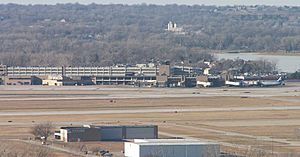
Omaha was called the "Gate City of the West" because of its important role in transportation. Even though President Lincoln said Council Bluffs, Iowa, should be the start of the Union Pacific Railroad, construction began from Omaha. By the mid-1900s, almost every major railroad served Omaha.
Today, the Omaha Rail and Commerce Historic District celebrates this history. The Burlington Train Station and the Union Station are listed on the National Register of Historic Places. The Union Pacific Railroad has had its headquarters in Omaha since it started. Their new headquarters, the Union Pacific Center, opened in 2004.
Amtrak, the national passenger train system, serves Omaha. The intercity bus terminal is downtown. Metro Transit is the local bus system.
Omaha's role as a transportation center was cemented when the Union Pacific Missouri River Bridge opened in 1872. This bridge connected the transcontinental railroad to other railroads. In 1888, the first road bridge, the Douglas Street Bridge, opened.
Most people in Omaha get around by car. Major Interstates like I-80, I-480, and I-680 serve the area. Omaha is laid out in a grid plan, making it easy to navigate. The city has proposed an Omaha Streetcar system for the urban core.
Eppley Airfield, Omaha's airport, serves over 5 million passengers a year. Many airlines offer direct flights to different cities. Smaller airports like Millard Municipal Airport also serve the area. Offutt Air Force Base is a military airbase just south of Omaha.
Famous People from Omaha
Omaha has been home to many famous people, including:
- Warren Buffett (investor)
- Fred Astaire (dancer, actor)
- Henry Fonda (actor)
- Gerald Ford (U.S. President, born in Omaha)
- Malcolm X (civil rights leader, born in Omaha)
- Gabrielle Union (actress)
- Andy Roddick (tennis player)
- Conor Oberst (musician, Bright Eyes)
- Andrew Rannells (Broadway star)
- Peyton Manning (NFL quarterback, his company is named Omaha Productions)
Omaha's Sister Cities
Omaha has eight sister cities around the world:
 Braunschweig, Germany
Braunschweig, Germany Shizuoka, Japan
Shizuoka, Japan Šiauliai, Lithuania
Šiauliai, Lithuania Xalapa, Mexico
Xalapa, Mexico Naas, Ireland
Naas, Ireland Yantai, China
Yantai, China Carlentini, Italy
Carlentini, Italy Isigny-Omaha, France
Isigny-Omaha, France
See also
 In Spanish: Omaha (Nebraska) para niños
In Spanish: Omaha (Nebraska) para niños


